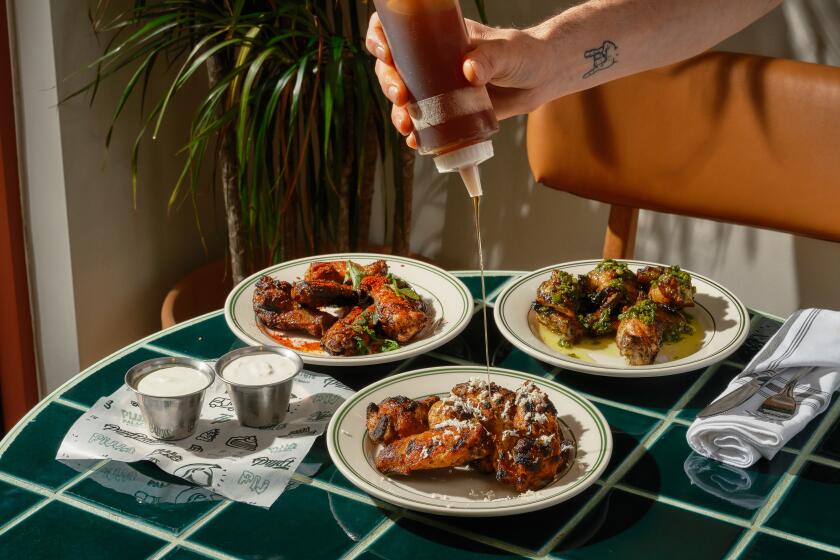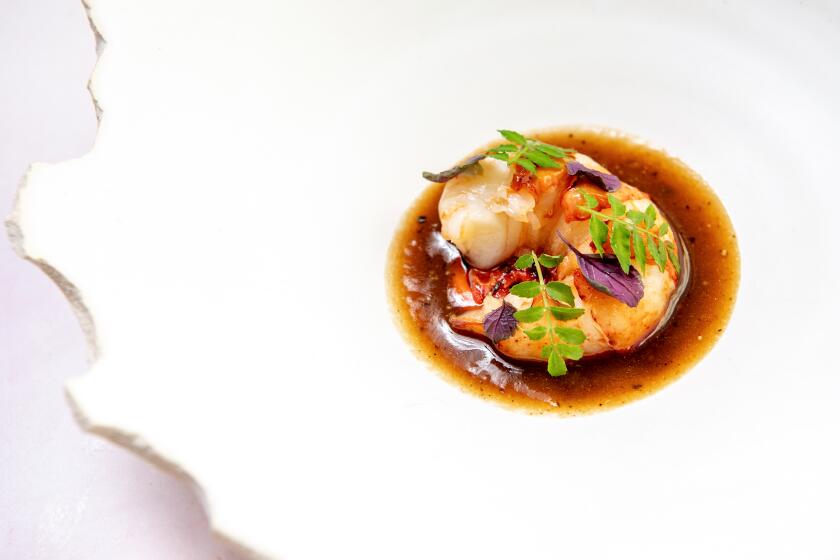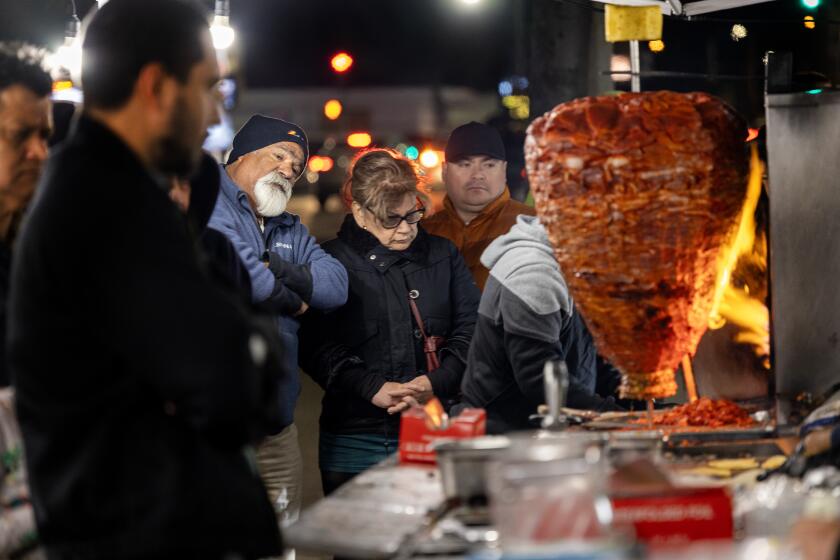Cookbook Trouble : Can This Recipe Be Saved?
During the course of researching this story, a lot people were only too happy to tell us about recipes that don’t work. Some gleefully bad-mouthed entire cookbooks. We took it all in and then eagerly went off to check things out. During the last six weeks, The Times Test Kitchen tested and retested some 50 recipes.
Sure, we had some real losers. The microwaved date and olive wrap-arounds from Sheila Lukins’ and Julie Rosso’s “New Basics Cookbook” came out looking like something dug up at the La Brea tar pits. And the two lemon pies from Martha Stewart’s “Pies & Tarts” book were both duds. Martha’s mile-high pie ran all over the plate, while the Marsha Harris version she offers as an alternative would have made excellent wallpaper paste. Besides neglecting to tell us to cook the lemon in a non-reactive saucepan, the cornstarch added to boiling water and lemon never completely dissolved.
And there was the flavorless pinto bean soup from John Sedlar’s “Modern Southwest Cuisine.” The recipe, which calls for one cup of pinto beans to three cups of half and half, comes out as weak-tasting as it sounds.
But surprisingly, many of the reportedly faulty recipes not only worked but tasted wonderful. One award-winning cookbook author griped that he never could get Rose Levy Beranbaum’s genoise to work. We did. Another complained of far too much chile oil in the spicy soba noodles in Mary Sue Milliken and Susan Feniger’s “City Cuisine” book. The noodles were delicious. Someone grumbled that there was way too much pepper in Paul Prudhomme’s recipes. Well, that’s his style of cooking. And Marion Cunningham’s gingerbread did not run all over the oven the way one authority claimed it would.
So many things affect how well a recipe works--equipment, weather, ingredients, personal taste. So what’s a cookbook author to do? Vigilance and thorough working knowledge of one’s recipes are probably the best insurance.
When well-known radio homemaker Evelyn Birkby was first going on the air in Iowa in 1950, her boss gave her good advice: “Think about the recipes. . . . Be conscious of what they should include. Test them so you are familiar with the way they go together and with the results.
“Never relax--recipes will clobber you if you do.”
*
Several people, including an important cookbook editor, complained that the seven-hour leg of lamb from Patricia Wells’ “Bistro Cooking” (Workman Publishing) didn’t work. “Cooking a leg of lamb at 425 degrees for seven hours is insane, not to mention it will blow up your oven,” griped one of the critics. We thought the method sounded ridiculous too--it seemed that if you were going to cook a lamb for seven hours, at least you should do it at a lower temperature. We knew we had a sure-fire loser.
We were wrong. The recipe turned out to be one of the best we’ve tested so far this year. And we never had to turn the oven temperature down once. The lamb was tender and full of flavor, and the tasters in The Times Test Kitchen couldn’t get enough.
Still, the method described in Wells’ book is somewhat confusing. After cooking the lamb for one hour, she tells us to add the wine and cook the lamb four to five more hours. After that, one hour before serving, she goes on to say, bury the potatoes and tomatoes in the liquid, cover and roast the lamb for another hour or so. But is that after the fourth or the fifth hour of additional cooking? Yes, she tells us the time will vary according to the size and age of the lamb, but it would help if we knew what the cooked lamb is supposed to look like at that point, or whether it would ruin the vegetables to cook them the full two hours.
We added the vegetables during the sixth hour of the total process, choosing the longest cooking time, so our recipe did end up being a true seven-hour leg of lamb.
AMBASSADE D’ AUVERGNE’S SEVEN-HOUR LEG OF LAMB 6 medium onions, quartered 6 carrots, peeled and quartered 1 head garlic, separated into cloves, each peeled and halved 6 bay leaves 1 bunch fresh thyme or 3 to 4 teaspoons dried 1 lamb leg, bone-in, 6 to 7 pounds Salt and freshly ground black pepper 2 (750-milliliter) bottles dry white wine, such as Aligote 5 pounds large boiling potatoes, peeled and quartered 5 tomatoes, peeled, cored, seeded and chopped
Layer onions, carrots, garlic, bay leaves and thyme on bottom of nonreactive roaster (with cover) large enough to hold lamb. Place lamb on top of onion and carrot mixture and roast, uncovered, at 425 degrees 30 minutes. Remove roaster from oven and generously season lamb with salt and pepper to taste. Return to oven and roast 30 minutes more.
Remove roaster from oven, leaving oven on. Place roaster on top of stove, slowly pour wine over lamb, cover, and bring liquid to boil. Return roaster, covered, to oven and roast 4 to 5 additional hours until lamb is fork tender, but not yet falling off the bone. (Timing will very according to size and age of lamb and type of roasting pan used.) Check on lamb from time to time, reducing oven heat if lamb begins to burn or liquid begins to evaporate too much.
When lamb is fork tender, bury potatoes and tomatoes in liquid. Cover and roast until potatoes are cooked through, about 1 hour more. Lamb should now be very tender, still juicy and falling off bone. Makes 12 servings.
Each serving contains about:
530 calories; 141 mg sodium; 95 mg cholesterol; 20 grams fat; 47 grams carbohydrates; 32 grams protein; 1.94 grams fiber.
*
We agreed with Tracy Templeton Jackson: Lee Bailey’s wimpy baked crab cakes bear little resemblance to the crusty fried ones, full of the taste of crab, that you find on the East Coast. There’s a whole stick of butter in the recipe, so it wasn’t as if Bailey chose to bake them in order to cut down on fat. (Supposedly it was for convenience, but it’s not exactly a big deal to saute a few crab cakes.)
Because the crab cakes are baked, rather than fried, they have a strange, wobbly texture. But even if you could get past their wobbliness, there’s so much filler and binder, the mushy cakes taste like something you’d find on a hospital tray.
We didn’t even bother to try to fix Bailey’s recipe. Instead, we found this example of Maryland crab cakes in Jane and Michael Stern’s “Real American Food” (Alfred A. Knopf). Filled with hunks of crab meat, an egg and some cracker crumbs for binding, and then fried in butter, the crab cakes are light and crusty and really quite delicious.
BEAUTIFUL SWIMMER CRAB CAKES 1/2 cup crushed cracker crumbs 1 pound lump crab meat, free of shell 1 tablespoon mayonnaise 1 tablespoon whipping cream 1 tablespoon mustard 1 egg, beaten 1 tablespoon minced parsley 1 teaspoon white pepper 1/2 teaspoon salt 1/2 teaspoon Worcestershire sauce Butter
Mix crumbs into crab meat. Combine mayonnaise, whipping cream, mustard, egg, parsley, pepper, salt and Worcestershire. Add to crab meat and stir only enough to blend. Shape mixture between your hands into 6 hamburger-like patties, taking care not to crush hunks of crab meat.
Heat 4 to 6 tablespoons of butter in large skillet. Set crab cakes in hot butter and saute until crisp and brown all over, about 3 minutes on each side. If cooking crab cakes in batches, add more butter for second batch. Makes 6 servings.
Each serving contains about:
267 calories; 671 mg sodium; 126 mg cholesterol; 21 grams fat; 5 grams carbohydrates; 15 grams protein; 0.03 gram fiber.
*
In his book “The New Texas Cuisine” (Doubleday), Stephen Pyles writes that if he had to choose one last meal, it would be this fried chicken. Craig Claiborne liked it so much when he tasted it at Routh Street Cafe, the Dallas restaurant Pyles once owned, that he included the recipe in his book “Craig Claiborne’s Southern Cooking” (without crediting Pyles).
While the recipes in both books are practically identical, the methods the two authors use are very different. Pyles calls for frying the chicken in vegetable oil at 300 degrees, a low temperature, to prevent the honey from caramelizing too quickly and burning. Claiborne cooks the chicken in half lard and half oil at a temperature of 360 degrees.
We tried both methods. Pyles’, listed below, worked perfectly--the chicken came out with a sweet, crisp, golden-brown skin. Claiborne’s method failed. His honey-coated chicken blackened almost as soon as it hit the hot oil, and by the time it was thoroughly cooked inside, the skin was charred and inedible.
HONEY-FRIED CHICKEN WITH THYME-MINT CREAM SAUCE 1 (3- to 3 1/2-pound) chicken 1/2 cup honey 2 tablespoons raspberry or other fruit vinegar 1/2 cup flour 2 tablespoons whole-wheat flour 2 teaspoons cayenne pepper 2 eggs 1/4 cup buttermilk 1 cup vegetable oil Salt and freshly ground black pepper
Thyme-Mint Cream Sauce
Cut chicken into 6 serving pieces and place in mixing bowl, reserving backbone, neck and wings for stock. Stir honey and vinegar together and pour over chicken. Marinate at least 2 hours, mixing occasionally.
In separate mixing bowl, combine flour, whole-wheat flour and cayenne. Set aside.
In another mixing bowl, whisk together eggs and buttermilk.
In large skillet, heat oil over medium-high heat to exactly 300 degrees. (Be sure to use reliable cooking thermometer. Honey coating on chicken will burn if oil is too hot. If too cool, chicken will be greasy.)
Remove chicken from marinade and drain on paper towels. Dip chicken pieces in egg wash, season with salt and pepper to taste and dredge in flour-cayenne mixture, coating thoroughly. When all chicken pieces are coated, strain marinade and reserve 1 tablespoon for sauce.
Gently drop dark meat chicken pieces in hot oil and cook until browned on 1 side, 5 to 6 minutes. Turn pieces over. Add white meat pieces and continue cooking, adjusting heat so chicken browns evenly without burning. Turn pieces again. Remove pieces as they become browned on both sides and tender when pierced with fork. Dark meat should cook 15 to 18 minutes total, white meat 10 to 12 minutes. Transfer chicken to 200-degree oven and keep warm while making sauce. Serve with Thyme-Mint Cream Sauce. Makes 4 servings.
Each serving, with sauce, contains about:
1,094 calories; 246 mg sodium; 237 mg cholesterol; 85 grams fat; 51 grams carbohydrates; 38 grams protein; 0.35 gram fiber.
Thyme-Mint Cream Sauce 1/2 cup dry white wine 1/2 cup chicken stock 1 1/2 cups heavy cream 1 1/2 tablespoons chopped mint 1 tablespoon chopped thyme 1 teaspoon lemon zest 1 tablespoon reserved marinade Salt and freshly ground pepper
Pour off oil from skillet used to fry chicken. Deglaze pan with white wine and add chicken stock, scraping bottom and sides of pan to free any browned bits that may have stuck during frying. Add cream, mint, thyme, lemon zest and reserved marinade, and reduce over high heat until sauce is thick enough to coat back of spoon, 5 to 6 minutes. Strain sauce and season to taste with salt and pepper.
Each of 4 servings contains about:
335 calories; 207 mg sodium; 124 mg cholesterol; 33 grams fat; 3 grams carbohydrates; 3 grams protein; 0.02 gram fiber.
*
When The Times Food section ran a recipe for chocolate chip cookies from “The Wolfgang Puck Cookbook,” angry readers called for weeks complaining that the recipe didn’t work. Although we test most recipes, this one got past us. Even after reducing the amount of flour by half, the cookies still weren’t right. They looked like pale little golf balls--and that was after they were baked.
We figured it might be the weird method Puck uses: creaming the butter, then slowly adding the rest of the ingredients, one at a time. So we made the cookies the usual way, by creaming the butter with sugar, adding the egg, the vanilla and then the dry mixture, but they still came out in a golf ball mode.
Then we increased the butter. That got the cookies to spread a bit, but they still didn’t taste very good. Finally, we gave up and developed our own recipe. Our cookies, which all our tasters approved, are made only with brown sugar instead of the half white and half brown that most versions call for.
BETTER THAN WOLF’S CHOCOLATE CHIP COOKIES 2 cups flour 1 teaspoon baking soda 1/2 teaspoon salt 1 cup butter 1 1/2 cups light brown sugar 2 eggs 1 teaspoon vanilla extract 1 (12-ounce) package chocolate chips 1 cup chopped walnuts
In medium bowl, combine flour, baking soda and salt. Mix and set aside.
In large bowl, using electric mixer, cream butter and sugar until light and fluffy, 3 to 5 minutes. Add eggs 1 at time, beating well after each addition. Add vanilla extract. With mixer speed on low, slowly add flour mixture just until blended. Add chocolate chips and walnuts and mix until blended.
Chill cookie mixture until stiff, about 1 hour. Drop dough by rounded teaspoons onto ungreased baking sheet, spacing them about 2 inches apart.
Bake cookies at 350 degrees until golden brown, 12 to 15 minutes. When done, immediately transfer cookies from baking sheet to rack. When cool, cookies may be stored in airtight container. Makes about 36 cookies.
Each cookie contains about:
161 calories; 128 mg sodium; 29 mg cholesterol; 10 grams fat; 18 grams carbohydrates; 2 grams protein; 0.21 gram fiber.
*
It was John Taylor, owner of a culinary bookstore in South Carolina and author of “Hoppin’ John’s Lowcountry Cooking,” who first alerted us to this recipe, so we’ll let him tell the story: “The banana cream pie at Emeril Lagasse’s restaurant in New Orleans was the best thing I’ve ever eaten, so I asked him to give me the recipe for my book. He told me it was his signature dish and that it would be in his new book (‘Emeril’s New New Orleans Cooking’), so all I needed to do was get permission (from the publisher to use the recipe).
“The book came out and I tried the recipe. It was horrible. It wasn’t anything like the banana cream pie I ate at his restaurant. I felt like I had been cheated. It was too sweet, it never set up and it called for mounds and mounds of whipped cream. I wrote Emeril and told him that although the crust was perfect and putting the banana in the crust was a brilliant touch, I was disappointed. I asked him to please send me the corrected recipe, but I never heard from him.”
Taylor was right on both accounts. The mashed banana in the crust is a swell idea, but the pastry cream filling is all wrong. Not only are the proportions way off (it’s as if someone with bad math skills tried to break down a restaurant-size recipe--to 3 cups of cream, Lagasse adds 2 1/2 cups of sugar, 3/4 cup of cornstarch and 5 large egg yolks), we had problems with the method, too.
So we tried to rebuild the recipe using a simpler technique. It wasn’t easy. We made the pastry cream at least 10 times, varying the amount of cornstarch, the egg yolks, the sugar, the method. Sometimes the pastry cream was too runny, other times too firm. Then we tried the simple method given in Helen Myhre’s “Farm Recipes and Food Secrets from the Norske Nook.” Myhre, known as Wisconsin’s pie queen, combines sugar, flour and cornstarch, stirs it together, then adds egg yolks and a bit of liquid before stirring again, gradually adding more liquid while stirring. Her method worked, but the hot, silky mixture still turned grainy when it cooled.
Finally, it dawned on us that the butterfat from all of that cream might be causing the problem. Continuing to use Myhre’s method, we switched to half milk and half cream, and the pie turned out perfectly.
BANANA CREAM PIE WITH BANANA CRUST AND CARAMEL DRIZZLES 1/2 cup sugar 1/4 cup flour
3 tablespoons cornstarch 3 egg yolks 1 1/2 cups milk 1 1/2 cups heavy cream 1 small vanilla bean, split and scraped 1 tablespoon butter Banana Pie Crust 2 ripe bananas Caramel Drizzle Sauce 1 cup heavy cream whipped with 1/2 teaspoon vanilla Shaved chocolate
In heavy saucepan, whisk together sugar, flour and cornstarch. Add egg yolks but do not mix in yet. Gradually add milk and cream to saucepan, mixing contents thoroughly as you do, using whisk. Stir in vanilla bean pod and paste scraped from inside bean.
Place saucepan over medium heat and cook until thick and smooth, about 12 to 15 minutes, stirring constantly with rubber spatula. Remove from heat. Remove vanilla pod. Add butter and stir well. Cover saucepan with plastic wrap to prevent skin from forming and let pastry cream mixture cool to lukewarm.
When cool, spread about 1/3 of pastry cream in bottom of Banana Piecrust. Peel bananas and cut crosswise into 1/4-inch slices. Arrange 1/2 of banana slices over pastry cream. Spread 1/3 of pastry cream on banana slices. Arrange remaining 1/2 of banana slices over that. Cover with remaining 1/3 of pastry cream and smooth out top. Cover with plastic wrap and refrigerate until firm, about 2 hours.
To serve, cut pie into wedges and drizzle warm Caramel Drizzle Sauce over. Top with whipped cream and shaved chocolate. Makes 8 servings.
Each serving contains about:
760 calories; 172 mg sodium; 274 mg cholesterol; 52 grams fat; 71 grams carbohydrates; 7 grams protein; 0.38 gram fiber.
Banana Piecrust 1 1/4 cups graham cracker crumbs 3 tablespoons light brown sugar 1/3 cup unsalted butter, at room temperature 1 small very ripe banana, mashed
In bowl, cream graham crackers, sugar, butter and mashed banana. Press into buttered 10-inch pie plate. Bake at 375 degrees until crust begins to smell of bananas, about 15 minutes.
Caramel Drizzle Sauce up sugar cup water 1 cup heavy cream
In saucepan, combine sugar and water and bring to boil, stirring often. Cook, stirring occasionally, until mixture is deep nutty-brown color and consistency of thin syrup, about 10 to 15 minutes. Turn off heat. Stir in cream, turn heat back on high and boil sauce 2 minutes. Remove from heat. Use immediately.
More to Read
Eat your way across L.A.
Get our weekly Tasting Notes newsletter for reviews, news and more.
You may occasionally receive promotional content from the Los Angeles Times.






